If you’re looking to build a survival stockpile, you obviously want to know the best survival foods that will last the longest AND you’d be OK eating for the long term.
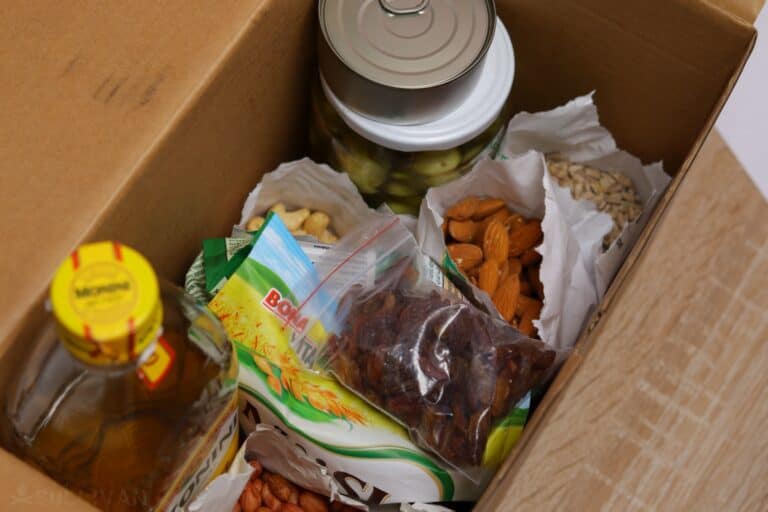
Of course, it’s not just which ones you choose; you also need the right containers, keep them at the right temperature and you need to protect them from pests and looters.
There are no less than 37 of them to choose from (and I’ll probably add more over time). The selection criteria are:
- shelf life
- price
- availability
- nutritional value
Not all of them meet all the criteria but I’m confident that this list is will give you plenty of options so you can have variety in your stockpile.
If you stick to it, you won’t need to look at any other lists (unless you or your loved ones have allergies or other medical conditions – definitely something to be concerned about).
So let’s get started with another one of my lists!
#0. Water
Water isn’t food but it is critical for your stockpile. If you have 3 months’ worth of food but only a week’s worth of water, you won’t survive for months on end unless you find alternate water sources.
#1. Canned Food
Well, did you expect anything else at the top of the list? Canned food is great for a number of reasons: it has a solid shelf life (when properly stored) and it doesn’t need to be cooked; you just open it and eat it.
Tip: don’t forget to stockpile a can opener as well!
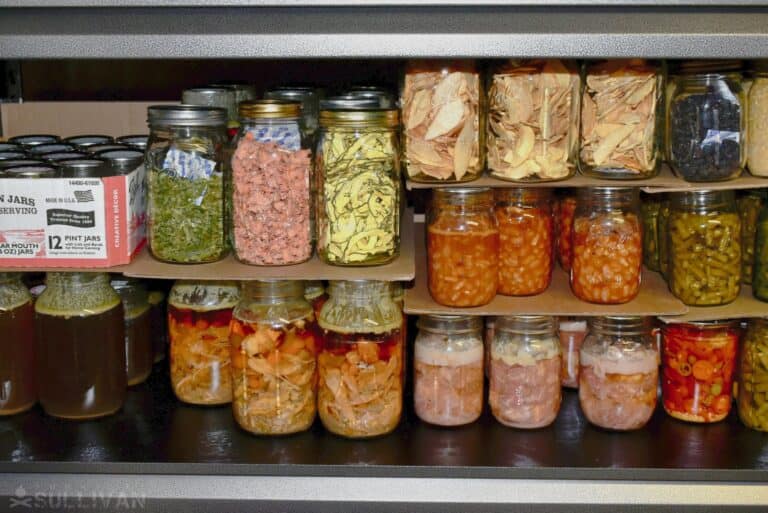
What food should you get? Any kind, as long as it has a long shelf life and you and your family would eat it.
Rule #1 is to always stockpile the foods you actually eat, not the ones you read about on some prepping blog that are the webmaster’s favorites, not yours.
That being said, you can get a wide variety of canned food, including: tomatoes, cucumbers, cauliflower, relishes, fruits, chestnuts, anchovies, corned beef, soup, spam, beef, chicken, potatoes, onions, ham, and even spaghetti and meatballs.
The shelf life of these foods varies but when they’ve been properly canned, you can expect them to still be delicious after 3 years (a lot more in some cases).
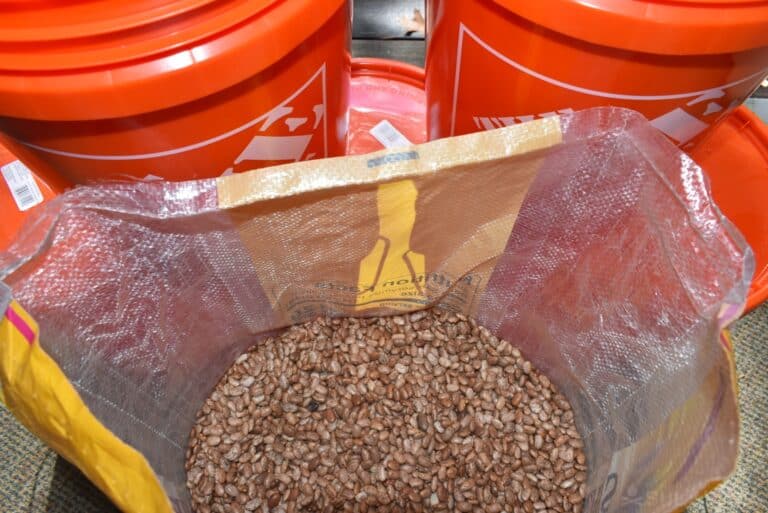
#2. Dried Beans
Pretty much any kind of beans you can get your hands on will do: black beans, pinto, kidney beans, etc.
Beans will last at least a few years (pinto beans usually last the longest). There are a lot of estimations out there that range from a couple of years to 30+ years but the critical factor is to know how to maximize this.
To do that, you need to store them in a cool, dark, dry place and, if possible, in vacuum packing.
Even if they won’t last you 30 years, you’re still going to eat them long before that when you rotate your stockpile (something every prepper should do).
The other important issue with beans is that if you don’t store them properly, they might be tough to cook when you finally decide to eat them.
You’ll probably need a pressure cooker to do this. But if you simply follow the two storage rules above, you shouldn’t have this problem.
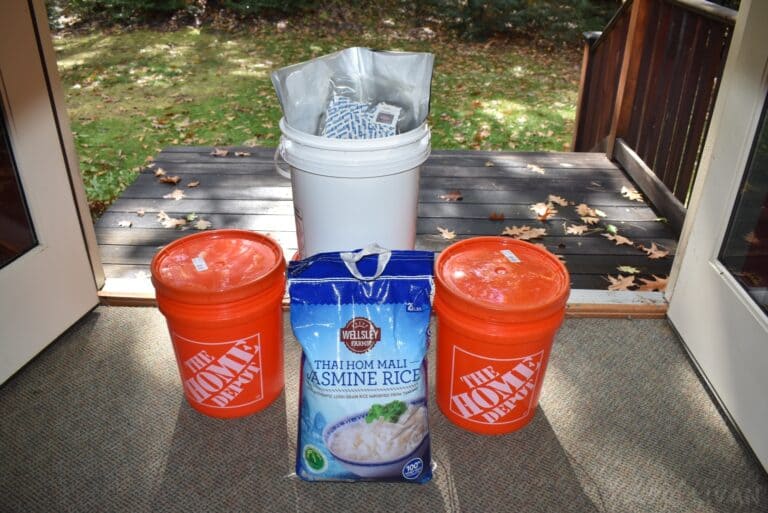
#3. White Rice
A lot of folks recommend brown rice because it has more vitamins, minerals, and a longer absorption rate, meaning it will give you a steady flow of energy for a longer period of time. But white rice is better for survival for one reason: it has a longer shelf-life.
White rice lasts for at least 4 years while brown rice won’t last for more than one (because the oils in brown simply oxidize faster).
So stockpile white rice unless, of course, your family enjoys brown and you eat it often enough to constantly rotate your supply.
#4. Pasta
Store pasta the old fashioned way (in Mylar bags with oxygen absorbers) and you can expect it to last for 15 years.
That’s more than enough, considering you’ll eat it far more often. The trick is to always consume from the bag that’s closest to the expiration date.
Again, keep it dry, cool, and away from pests. One other thing you should with is keep it in the freezer for 4-5 days before you actually store it to make sure you kill any larvae eggs inside.
If you don’t do this, after a few weeks, you might wake up with little black bugs inside…
#5. Dried Hazelnuts
Nuts are a very good source of protein and healthy fats. The reason I recommend hazelnuts is that they have the longest shelf life, of around 2 years (source). Of course, you would have to store them at freezing temperatures (32 F or 0 C).
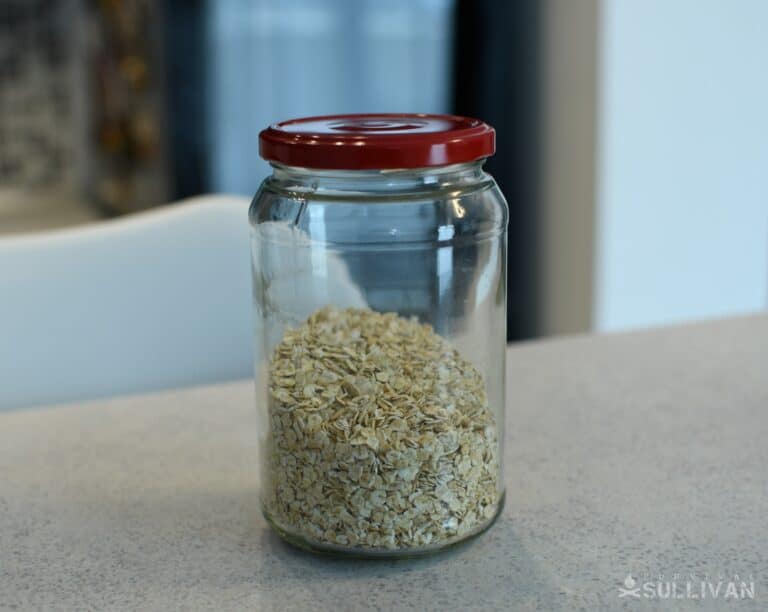
#6. Whole Grains
You should stockpile whole grains instead of flour for a very good reason: flour doesn’t last more than a year. In fact, its shelf life is closer to 6 months, so go ahead and store whole wheat, rye, barley, oatmeal, etc.
As a general rule, you want to store the ingredients of something instead of the processed/final produce for maximum shelf life.
For example, it’s much better to store cocoa than chocolate because one last for 2 years while the latter lasts less than one.
Caveat: if you’re gonna store whole grains, you’re also gonna need a grinder. Something you might not find post-collapse with all the stores being closed and everything.
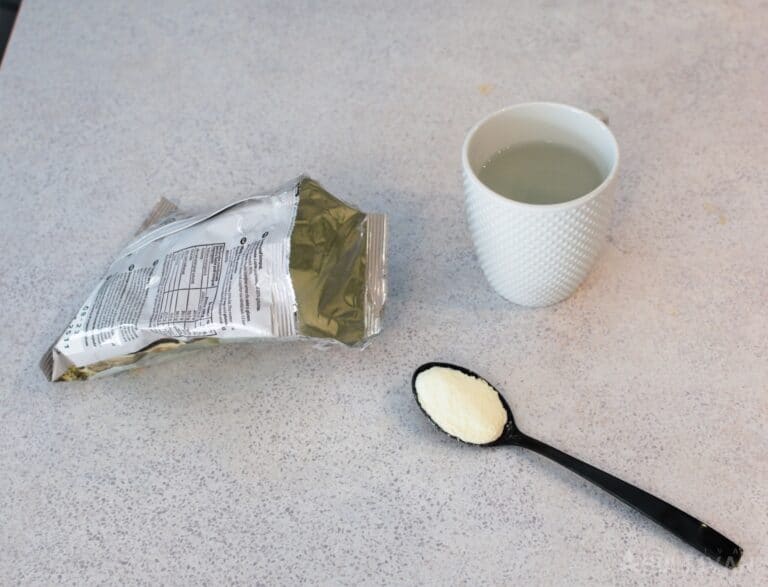
#7. Powdered (Dry) Milk
This is another good protein source but it has a BIG advantage over other foods such as grains and mushrooms: it has a complete protein, meaning it has all the essential amino acids that your body cannot produce on its own but it needs in order to properly regenerate muscle (among other things).
I’m not saying incomplete protein is bad but complete protein is better, and powdered milk has it.
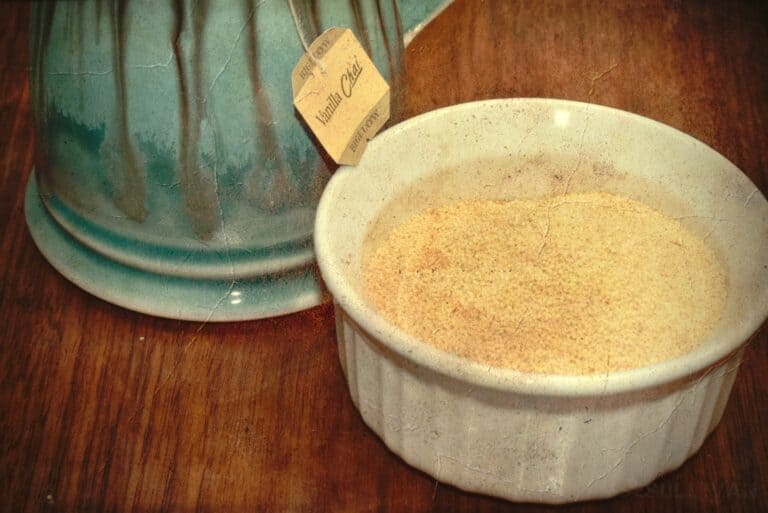
#8. Honey
Honey is a FANTASTIC food to stockpile not just for doomsday but for every day. It has a virtually unlimited shelf life and can give you all the energy you’ll need during and post-collapse.
You can even dehydrate it so it’s easier to take you in an evacuation.
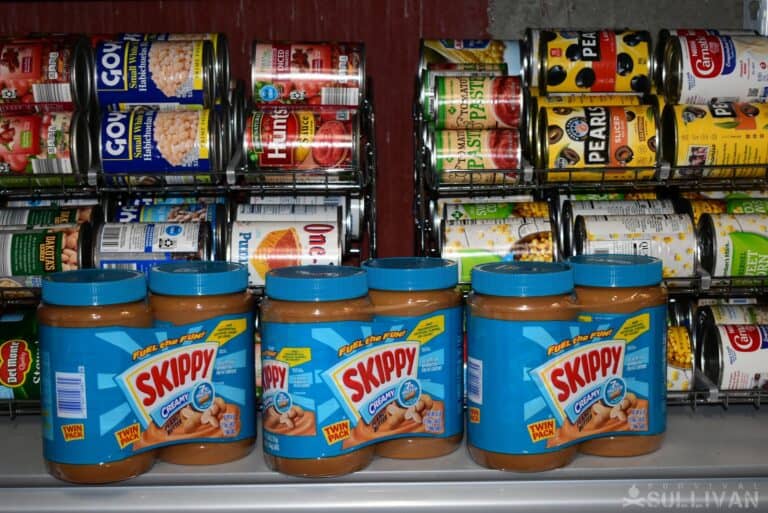
#9. Smooth/Crunchy Peanut Butter
Peanut butter is yet another comfort food that can last for years, but there are a few conditions that have to be met first. Besides storing it in a – you guessed it – cool, dark place, you also need to make sure you get a quality brand. Jif, Skippy, and Aldi are all great choices.
To make sure the jar is safe to eat when you open it, check that it’s still creamy and soft and that the color hasn’t darkened.
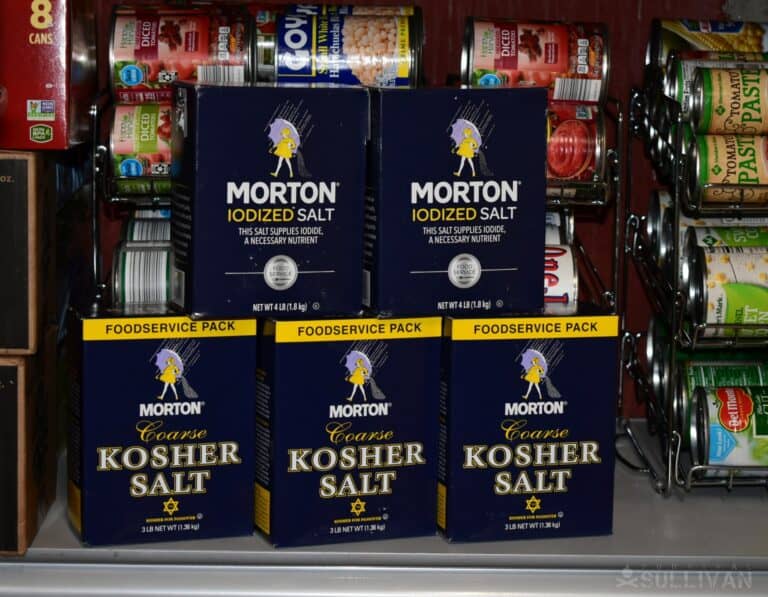
#10. Iodized Salt
Salt is essential for the human body and, although a lot of foods have it, it’s a good idea to have a supply of iodized salt stashed away somewhere. It’ll make your food taste better, too.
You can store it in Mylar bags but do not use O2 absorbers.
Salt will last forever because most bacteria and fungi cannot survive in a salty environment. Let’s not forget we use it to preserve other foods such as meat.
#11. Sugar
Just like salt, store it in Mylar bags and skip oxygen absorbers. The shelf life is said to be indefinite.
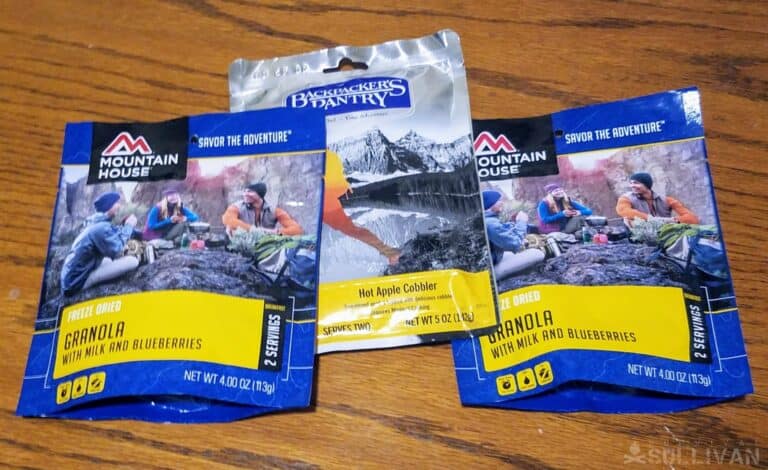
#12. Freeze-Dried Food
Freeze-dried foods are perfect for bug out bags because they’re lightweight. The idea behind this is to remove every trace of water.
In order to consume them, one would need adequate amounts of water to reconstitute the actual foods. Keep that in mind as you’re bugging out, because drinkable water may be an issue.
#13. Cocoa Powder
Cocoa powder has a shelf life of at least 2 years, and you can make a lot more than homemade chocolate from it. Think brownies, cookies, chocolate fudge, chocolate shakes, and on and on.
You’re much better off stockpiling powder than actual chocolate from a shelf-life perspective.
#14. Pink Salmon
Why PINK salmon? Because it has one of the best shelf live of all canned fish foods, somewhere around 3 – 5 years. This is the reason I didn’t just list in along with the other canned foods.
Of course, this only applies if you don’t open the can and store it in proper conditions (in a cool, dark place). If you open it, it’s best to eat it in the following 2-3 days and always keep in in the freezer until you finish it.
#15. Cooking Oil
The oils with the longest shelf life are also the ones that are the most widely used for cooking: sunflower, coconut, and extra-virgin olive oil. A secondary use for cooking oil is that you can use it as emergency lighting.
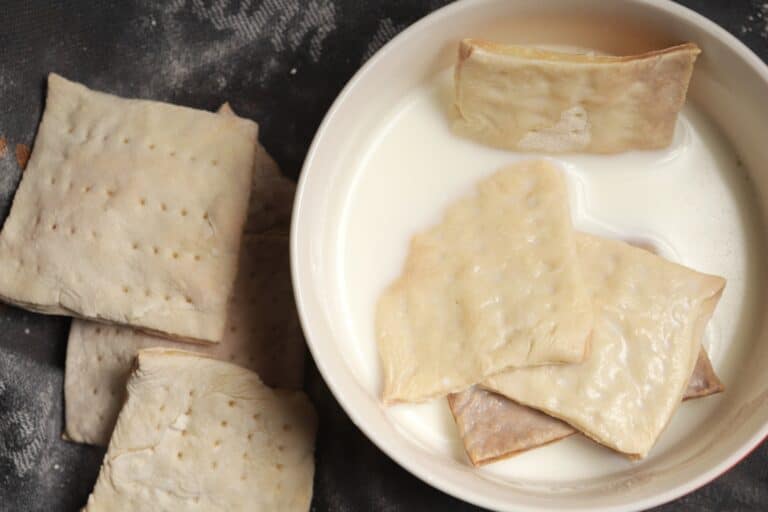
#16. Hardtack
Never heard of hardtack? It’s a type of cracker made of flour, salt, and water. These are also called sea biscuits or sea bread. You can just store the ingredients and make them anytime you want!
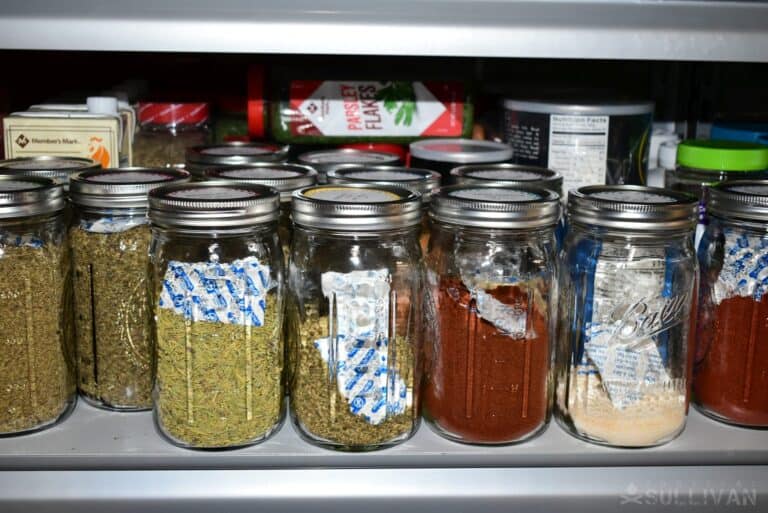
#17. Spices and Herbs
Just because it’s the end of the world, this doesn’t mean you can’t enjoy a delicious meal.
Go ahead and store any of the following condiments in Mylar bags with oxygen absorbers (and make sure you remove them from their original container first):
- whole pepper
- garlic powder
- paprika
- cinnamon
- chili powder
- rosemary
- basil
- oregano
- and other herbs you think you’ll need
#18. Jams and Jellies
Blackberry, strawberry, raspberry… mmm.
While some sites suggest that the shelf life of these foods is somewhere around a year, when you seal and store them properly, you can realistically expect 5+ years.
If you’re worried, you just have to make sure you eat them within the 1-year frame, of course.
#19. Protein Bars
Food bars have a really long shelf life and they’re very good to just throw in your bug-out bag. Some of them can last 5 years so they won’t pose any problems when it comes to rotating your stockpile.
Energy and protein bars may give you the required carbs in an emergency but they’re more expensive than peanut butter, for instance, and they contain a lot of preservatives that aren’t really good for you. Use them as emergency food only.
If you don’t know where to start with energy bars, try Millennium bars. They have a lot of flavors and a 5-year shelf life.
#20. Popcorn
Popcorn is one of those comfort foods that everyone will love post-collapse. It has a long shelf life when properly stored (except for microwave popcorn and popped popcorn).
#21. Juice Powders
Lemon, lime, pineapple, orange, you name it. I for one can still remember Tang, the powder that I used to mix with water and drink like crazy when I was a kid.
Obviously, they’re not the same as the real deal but it’s better than nothing. Once you stockpiled the essentials above, including the two main comfort foods I recommend (peanut butter and honey), you’re gonna want to add variety to your pantry.
Juice powders will last a looong time when properly packaged and stored.

#22. Hard Candy
Store them in airtight containers to give your family a taste of what it was like when things were “normal”.
You may want to skip O2 absorbers, though. Just keep them away from heat, light, and moisture and they’ll be fine. Examples of candy with a long shelf life:
- candy canes, Skittles, Starbust – 2 to 3 years
- jelly beans – up to 2 years
- chewing gum (up to 18 months) – not many calories in it but it’s great to fight off stress
- candy corn, sour ropes, plain M&Ms- 1 year
- caramels – 8 to 12 months
- you can also make your own candy
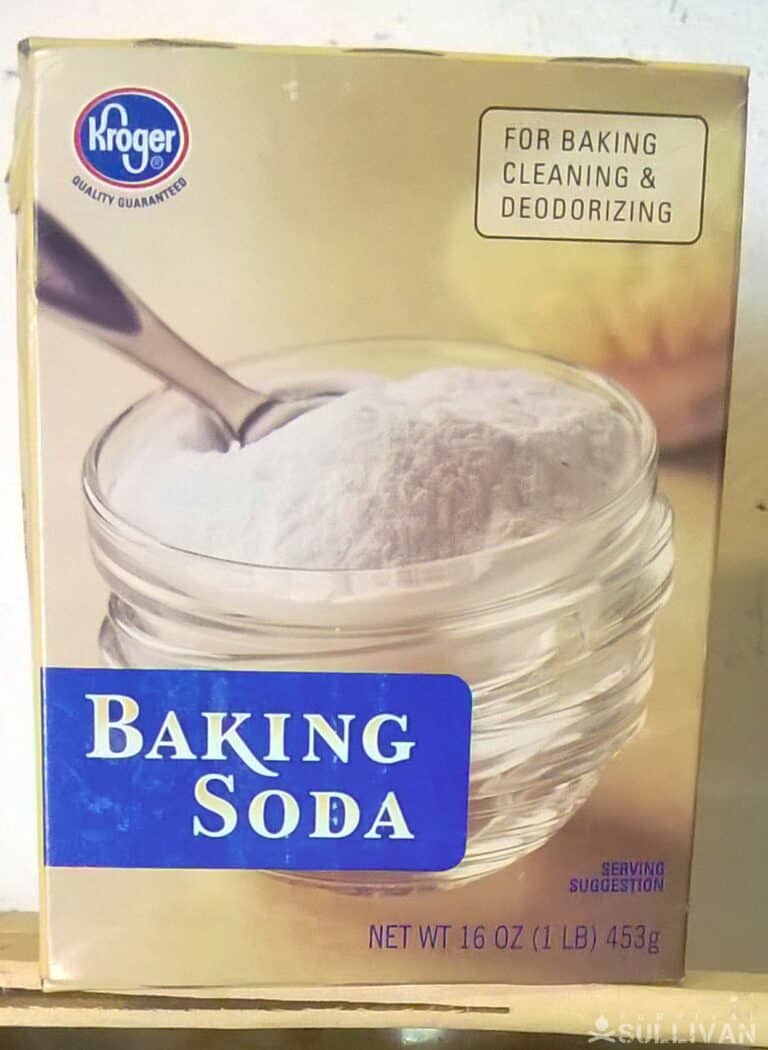
#23. Baking Soda
Besides the obvious, use in cooking things like pancakes, cakes, and so on, baking soda has a million and one uses. For example, did you know you can mix it with a little bit of water to make homemade toothpaste?
#24. Powdered Cheese
This is a great option for your pantry. Did you know that dehydrated powdered cheese has a shelf life of 10+ years?
#25. Powdered Eggs
Most preppers choose to buy them instead of making them at home. Shelf life is great, by the way, 5 years plus.
Hint: if the omelet doesn’t taste great, add some extra salt, pepper, and maybe even some onion.
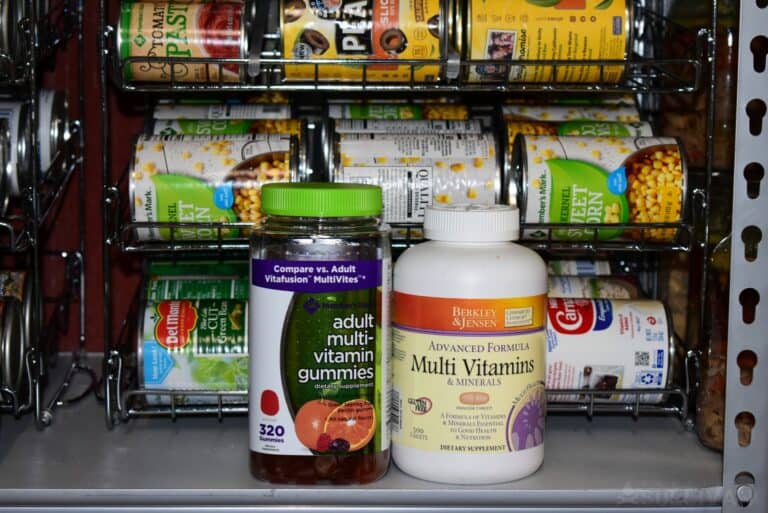
#26. Multivitamins
The thing with vitamins & minerals is that, at some point after you store them, they start reacting with each other. Still, using Mylar bags and oxygen absorbers is going to give them a shelf life of at least a couple of years.
If you can, store each important vitamin separately but rotating them is key. Taking vitamins every day as supplements is a good idea as long as you don’t rely on them for your daily micro-nutrient requirements.
#27. Coffee
Coffee is not only great for boosting your energy but it is going to make one heck of a bartering item. Not any coffee is going to last long enough.
What you want to stockpile is green unroasted coffee beans that you should pack in Mylar bags + O2 absorbers. Post-SHTF, you will have to roast and then grind the beans to make coffee.
#28. Tea
Just store tea in Mylar bags, put some oxygen absorbers and you’re all set to drink your favorite beverage when everyone else is going to be desperate for a loaf of bread.
#29. Vinegar
Vinegar is an acetic acid as a result of fermentation and it has a lot more uses than making your soup taste better. Use it as a disinfectant, to remove grease from dishes, to treat a sore throat, and so on.
Because of its acidic nature, vinegar has an indefinite shelf life.
#30. Instant Potato Flakes
Store instant potatoes as you would rice. Mylar bags, and oxygen absorbers, put them in a cool dark place and you’re done.
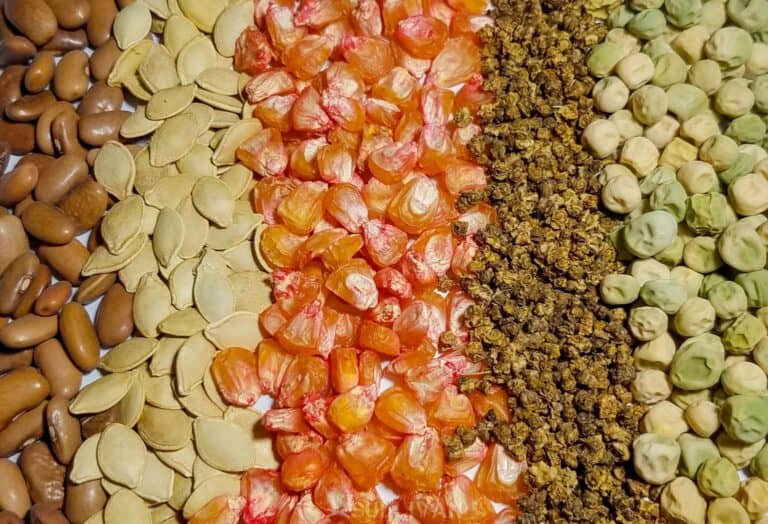
#31. Seeds
You’re going to need seeds for your post-apocalyptic survival garden, and there are quite a few companies that sell them.
Choosing the right seeds is tricky, you can’t just pick anything (you need to know which ones will grow in your region) and you need to know how to store them and how to plant them.
#32. Bouillon Cubes
The problem with bouillon cubes is that they can go rancid past their 1-year shelf life.
Other than that, they’re going to be a blessing post-collapse as they can make beans and rice taste better, AND they can even be a very good replacement to coffee and tea as a hot beverage.
The salt content is also great as your body will need it in order to function properly.
#33. Pemmican
Pemmican is a mixture of fat and protein from large game such as buffalo or deer. Traditionally, the fat and protein were dried, mixed, and pressed. Its shelf-life depends on storage conditions and the quality of ingredients.
It doesn’t even have to be refrigerated or even cooked, although keeping it inside the fridge will cause it to last longer. Let’s not forget that pemmican has a high-fat content and fats go rancid with time.
You can buy Pemmican, or you can make your own.
#34. Yeast
To maximize its shelf life, store it in a cool place such as your freezer. If you completely freeze it, it can even last you more than 3 years.
#35. Hard Liquor
A lot of people will do anything for a bottle of Jack when they’ll look outside their window and see how the world went down the drain.
You can stockpile as many distilled beverages (such as whisky and vodka) as you want because, even if you won’t drink them, you can still barter with them.
The bad news is that you can’t store any beer, though, it doesn’t have a long shelf life.
#36. Dehydrated Fruit
The shelf life of dehydrated fruit varies widely, but in proper conditions, you should expect at least one year of shelf life.
Some of the things you can dehydrate include apples, apricots, bananas, mango, and peaches. You can use a dehydrator to do this, or you can do with using only the sun.
#37. Granola Bars
Though the shelf life of granola bars is 6 to 8 months, it’s included here for some VERY good reasons, namely:
- they’re safe to eat past the expiration date
- you can increase their shelf life if you store them at a low temperature in a cool, dry, dark place – you knew this, right?
- it’s an excellent food for bug out bags because it’s lightweight, making it easy to carry
Bonus
These might not be essential (at least not for everyone), but they’re worth considering…
#38. Pet Food
Well, you can’t expect Lucky to starve post-SHTF, right? Pets will play a huge role: cats can catch mice (there will be plenty of them, anyway), and dogs will protect you from burglars and other bad guys.
Let’s not forget that pets are going to be a joy for you and your children when the Internet and electricity will be gone.
The only problem with dog food is that it’s high in fat, meaning you’ll have to rotate it at least every year. But since Lucky’s survival food happens to be the same one he eats on a daily basis, food rotation is the least of your worries.
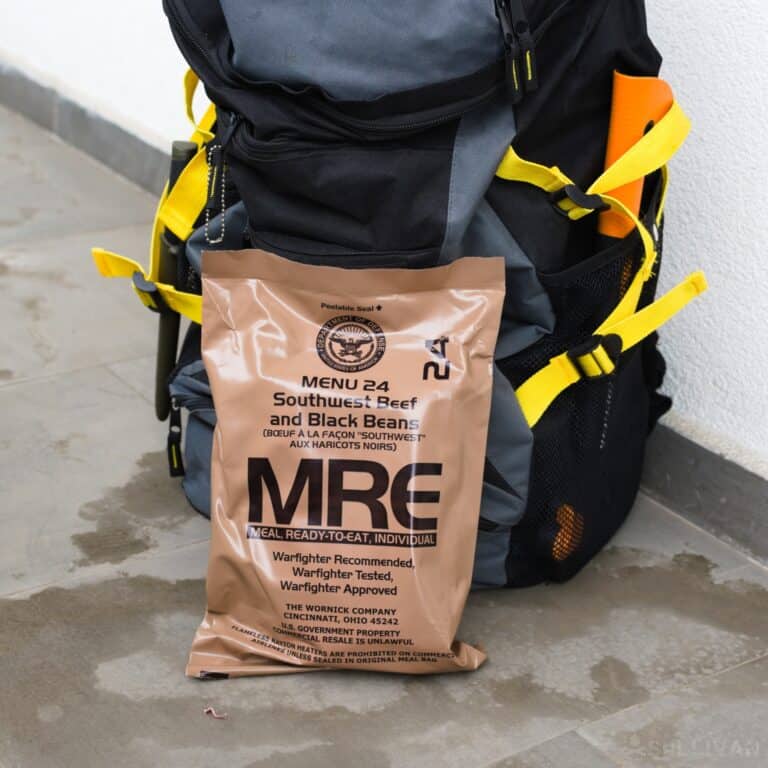
#39. MREs
What? Am I recommending meals ready to eat?
Yes, MREs are expensive and they’re not quite as tasty and healthy as the other options listed above but they are decent if you’re not a seasoned prepper and you’re only looking to build your emergency stockpile.
After all, this is EMERGENCY food, right? Once you built your 72-hour stockpile, I recommend you focus solely on foods the other type of foods shown above.
Do you think there are other food items that should have made it to the list? Write them in a comment below.
P.S.: you can get a PDF with all the foods right here to print off or just save on your phone or Kindle.
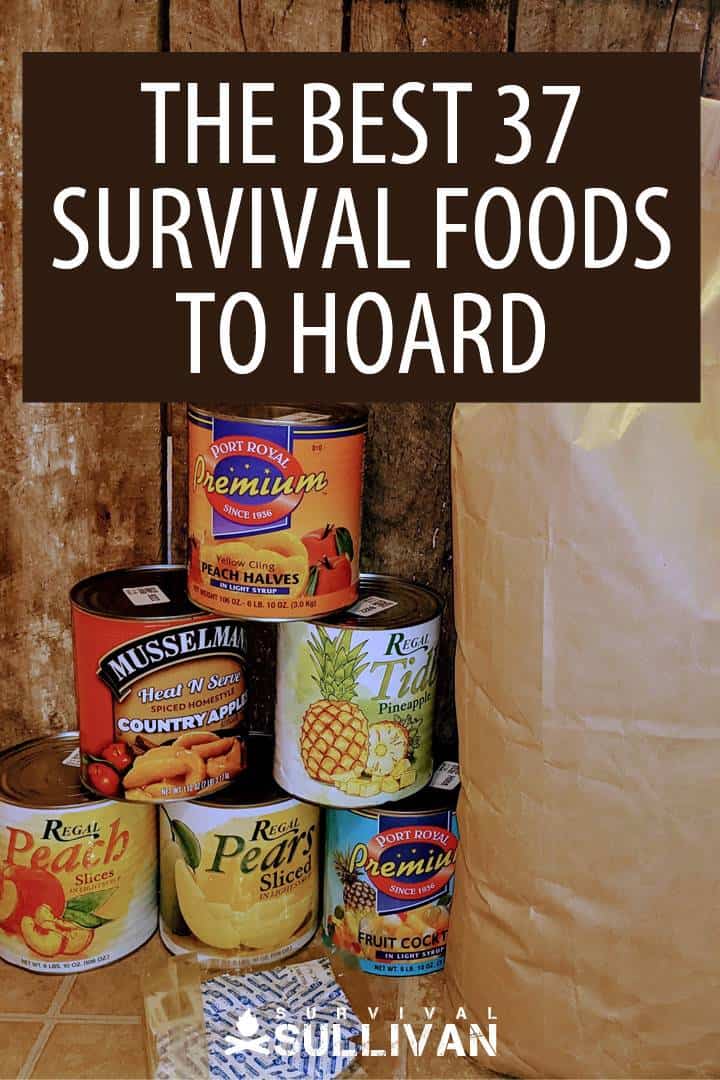
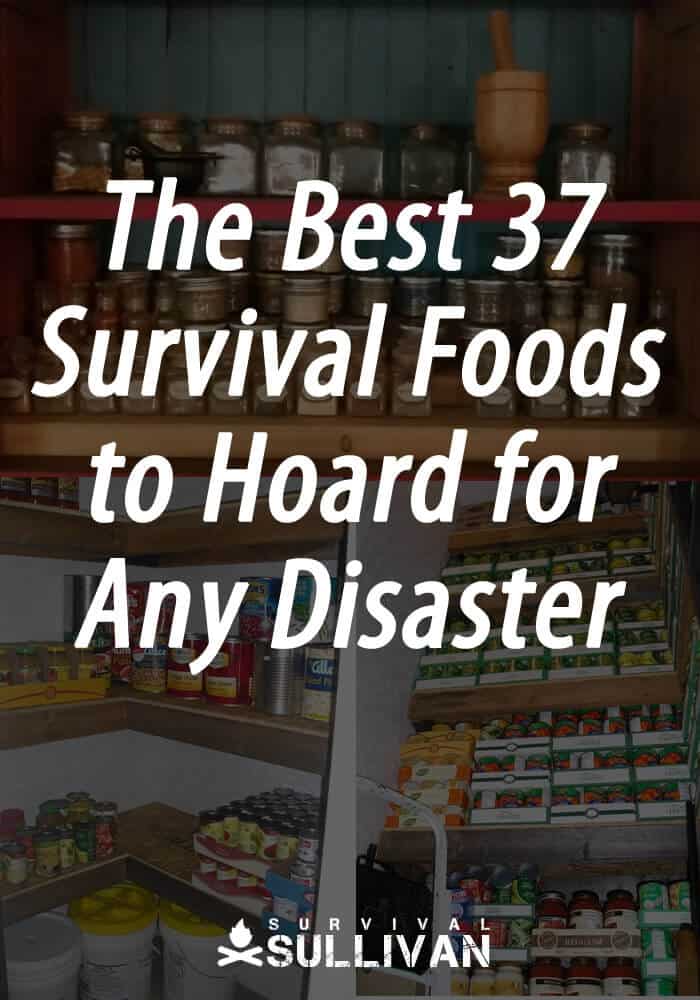

My dad was military. My grandfather was a cop. They served their country well. But I don’t like taking orders. I’m taking matters into my own hands so I’m not just preparing, I’m going to a friggin’ war to provide you the best of the best survival and preparedness content out there.

1. Canned Foods: Provided the seal of the can isn’t rusted on the INSIDE of the can the contents are safe to eat. Proof in point, canned goods from expeditions to the (Ant)Arctic were tested after lying there for 60+ years and the food was still edible and tasty, according to the scientists who tested it.
2. Dried Beans, as an experiment try planting some of your dried beans. For me germination was good and gave me plenty of fresh beans, so the loss of beans through planting was nothing compared to the crop each one produced, one good bean plant easily produced around a quarter of a jarful of beans, around 250 grams before drying. Before storing long term I dry them first in a dehydrator so they keep for a long time.
31. Seeds. I gather seeds from the vegetables I grow. Many are bi-annual so don’t produce seeds until the second year of growing. Gathering seeds takes a certain amount of effort, but the I still remember the first year I planted my own harvested seeds of beetroot, sprouts, carrots, parsnips, broccoli, cauliflower, pumpkins and a variety of different onions. The excitement of those first shoots appearing is still there every year.
One tip to avoid wastage is to make your own planting tapes. I use cheap masking tape and old newspapers for this. Just lay the tape sticky side up and place the seeds at the right distance according to spacing instructions for the seeds you’re using, then put the newspaper over the top and flatten it down, then roll the tape up. When the time comes to plant them you just scrape a trench the right depth, lay your tape out newspaper side up, and cover over.
What an awesome idea for saving seeds on tape ! I have been gardening most of my life and have never come upon this idea ! Thank you so much for sharing. Judy
Thank you for this share. All of it, but seed tapes for sure. How old were your beans? I have found similar with canned foods–never had dates in years past and they were good many years. One consideration however—the pull top cans I believe will be shorter shelf life.
i know from my Mom that most items keep forever. She grew up in depression and saved everything. Canned goods last 5-7 yrs after exp date, dry things forever. I think you are probly right on pull tops which now is most things.
Fantastic on planting dried beans AND making your own seed tape. Thank you VERY much! I will use this idea this fall to plant soon and in spring. What an innovative idea!
Great idea! I’m going to do this right now!!
please rank dogfood HIGHER: Marilyn Vos Savant (the HI-IQ lady) said
the ONE food which would provide the most nutrition for humans is Dog Food.
You aren’t seriously PLANNING on eating that stuff?
OTOH, please prep pet food to take care of your pets. You don’t want to watch them starve and they can’t take care of themselves in nature – turning dogs loose will endanger children.
Wow, I don’t know where to start. Being a baby boomer, I have learned a few things since the cold war. However, you’ve introduced me to some things, ideas and lessons I didn’t know, thank you! Also, if you haven’t thought of it, is herbs, weeds and other things you can forage. I am learning about these also.
Thanks again for ALL the info..
There are many types of dried and dehydrated mushrooms, soy protein and items such as quinoa that also have high nutritional value and would provide variety. Rehydrating these are very simple and many recipes can be adapted for use instead of meat. You can also make your own vinegar….maybe researching some of these “old ways” in advance would be good, so that storing items like bulky vinegar becomes redundant. Yes, some of the better dog foods such as Adana and Orijen (both made in Canada by Champion Foods) have high crude protein(up to 38%) and fat levels(up to 18%) made from whole prey meat and fish products, vegetables and whole eggs (no by-products) These would be acceptable as human grade products in emergency situations. Suggesting candy….not my idea of a good thing….you can’t visit the dentist every 6 months for fillings. Hard cheese is another thing that would be good for the short term….after all, they didn’t have refrigeration 100 years ago and cheese was a staple back then. Something like parmesan, adagio or romano would be my choices. Instead of Juice powder and sugar, might I suggest syrups instead…they would last a long time and can be used for any number of substitutions in recipes.
Essential Oils such as frankinsence, cloves, oregano can also be used for a number of things….these are all antibacterial, antifungal, antiviral and can be used for numerous things including cleaning teeth, upset digestive sytem, colds, flu, etc. Swedish Bitters is essential for anyone with heart burn, digestive ailments, IBS, gall bladder problems, etc. The herbs and ingredients are available in packages and once mixed with vodka and allowed to sit for 30 days, this mixture lasts a very, very long time. Couple of drops in a glass of water and 30 seconds later, relief. After straining, the herbs etc can be used once again in a fresh bottle of vodka.
Thank you. Must learn more about making tinctures for sure. I believe Honest Foods dog food also human grade
Madeline, thank you for mentioning Swedish bitters. I have not heard of them and will look them up posthaste. I also use essential oils. They have many uses. Thank you!
Because is about money.
Here are a couple of more ideas of comfort food to help kids with the transition — apple sauce pouches and prepackaged pudding. Both last fairly long (usually a year or more). One also could can their own applesauce, which would last longer, or use powdered milk to make fresh cooked pudding (although powdered milk is not recommended on the package). I’ll have to try it to see how it will work in an emergency.
Another good item which has a fairly long shelf life is almond milk. It does not have to be refrigerated until after it is opened. I’m stocking up on these in an amount that I can reasonably use prior to their expiration date. I am lactose intolerant and plan to use the almond milk for as long as it lasts. I’m trying to find a source for powdered almond or cashew milk. I have seen a recipe online for making it, so I guess I could make it with the actual nuts and water.
On another note, I would love it if you have a recipe for making powdered milk. I have seen how to make powdered eggs online to save the expensive cost of buying these, but I have not found powered milk recipe yet or know if it is possible to do in a home setting without a lot of expensive equipment.
Thanks for your insight, advice, and guidance as we all learn together!
Hi Starla,
Regarding the powdered milk recipe, I added it to the list. Hopefully, one of the writers has done it or at least knows the recipe and is willing to try it.
Regarding almond oil, I checked and it only lasts for a few months unopened? Maybe we looked at different sources…
Quick update: Teresa wrote an article on making powdered milk: http://www.survivalsullivan.com/make-powdered-milk-home/
I’ve never used a dehydrator so I’ll throw this question to all. Twelve hours of powered dehydrator use for X amount of powdered milk seems expensive (compared to buying large boxes of it from the store and repackaging in mylar). Am I off-base?
I have canned whole milk, which is over a year old at this point and it works great for cooking and tastes good when it is cold. I have also made sweetened condensed milk, starting with powdered milk and when I need evaporated milk I make that too. It’s easy to heat milk to half the amount.
Homemade fruit rollups are easy and a nice treat for the kids.
If you need almond or cashew milk just store the almonds or cashews there are a ton of tutorials on how to make your own almond or cashew milk and it is usually really simple just soaking the nuts then blending them and straining the results. That would be a lot more emergency food safe than storing boxes of prepackaged almond or cashew milk that do need to be refrigerated unless you buy specifically the shelf stable ones
Yes, it is very easy. I hand made it for a commercial company and while it’s slow it’s simple. You will need a fine mesh bag though and I don’t know if anything works as well as cheese cloth.
You can make your own cooked pudding using powdered milk and won’t really be able to taste the difference except for it being a little less creamy (because most commonly available powdered milk is non-fat).
1/2 cup sugar, 1/4 cup cornstarch, 3 Tablespoons cocoa powder (if you want chocolate pudding, which I always do), dash of salt, 3/4 cup powdered milk, 2 3/4 cups water, a couple tablespoons of butter and some vanilla, if you have them. Mix dry ingredients. Add water. Bring to a gentle boil over medium low heat, stirring constantly. Remove from heat and add butter and vanilla, if using. It’s great warm as well as cold. It does get a skin on it, but I always liked that part best. The butter and vanilla are nice additions, but I have often made it without either and it is still good.
You can even make up packages ready to use with just adding water. Just mix all the dry stuff and put it in a bag or jar. It should have a shelf life equivalent to that of the shortest shelf-life ingredient.
I I have seen where you can freeze whole eggs in a freezer.
Crack them open in a silicone cup cake and then freeze them. Take them out of cupcake and put in a freezer bag. When time to use them, thaw them out ahead of time
Read it’s important to break the yoke & stir around abit, then add a little salt. This keeps the yoke from becoming gelatinized when frozen….which would be noticeable.
I have a couple types of oatmeal, rolled oats and steel cut. They keep for years ( not the flavored one) and can be used for breakfast and homemade bars, ad well as granola and even flour. Storage is a snap as all that’s needed is a cool dry space.
What about canned or foil pouch tuna? Or canned chicken? Maybe I just missed them in the list
Sharon: I believe that tuna in a pouch would have a much shorter shelf life than the canned version. It was created to be easy to just toss in your lunchbox and easily enjoy it. It’s more of a convenience product than anything else. Pouches are easily punctured as opposed to cans, which is why I wouldn’t recommend it for any longer-term storage. The pouch version often has other ingredients than just tuna, such as mayo, that are also a higher risk for accidental contamination. I don’t eat the stuff myself, but my roommate does, and he said he’d prefer to use the canned for any type of emergency, and store any mix-ins separately. He has stocked a few of the single-use mix-ins, such as you might get at a diner–think catsup packets, etc. That way you don’t have to worry about using or refrigerating any unused mix-ins. And there’s less weight if you need to carry your foods.
PLEASE remind folks that for any electric appliance they currently use, they WILL need a non-electric one if the SHTF. Like can openers, cooking pots, whisk, corn popper, coffee grinder, coffee pot, etc.
Currently I use the old fashioned can-opener, like we used to have that is screwed into the wall. As I got older, I found that I was unable to manage the “squeeze” type. Maintenance in my building installed it. I also have some P-55’s [Military can openers]. New ones are still available.
And MORE water to rehydrate any dehydrated foods, drink mixes, dry milk. It’s all a waste if you don’t have enuf water to use it.
I DON’T COMMENT OFTEN ENOUGH BUT THANK YOU !
Again, an entertaining and informative article! I would also suggest coconut oil for its cosmetic and healing properties (as well as food) and herb seeds – culinary as well as medicinal. Also a really good herbal for identifying/gathering wild herbs and for showing uses. Be sure you get one that gives dosage and preparation instructions.
Dried fruits and veggies are super simple to make, and can be powdered to make your own drink mixes. Add sugar as needed. If a temporary event occurs & you lose power for your freezer, all your fruits & veggies can be dried without any prep (such as parboiling). The cell walls are already opened, allowing safe & easy dehydration. I keep some new screen on hand to make into drying screens. Make sure you put a screen on top if you have fly problems or raise them over 12 feet in the air (not many flies that high). I use a regular stapler to secure the screen to pieces of weed. Make them small (1×2 foot at the most) as they get heavy and saggy when loaded otherwise. Lots of books out there, if I can find my fave soon, I’ll update this comment. Thanks for the great ideas.
#35: You can store certain beers for a very long time, 10-20 yrs. Go with high alcohol percentage styles such as imperial stouts with 12+% alcohol. I’ve had a beer that was 15 years old and was still great.
Don t forget about medications, toiletries and distilled water especially if you have a CPAP which we run from a marine battery if our power goes. But this list is really helpful. Thank you.
Thank you for mentioning the marine battery! I have been trying to find an economical way to power my CPAP when the power goes down!
Reki,
I was in consumer sales so mealtime was never consistent. I used to save all the condiment packs I could in case somebody ran for the sandwiches and forgot them. I had a little box in my desk drawer where I saved them. As I cleaned out my desk after retiring, I found that not all were still good. Please be careful with those.
Like all other preps, those packets should be dated and rotated on a fifo basis. I do it by putting all condiment packets that I get in a calendar month in a ziplock baggie with the month/year on a piece of paper inside the baggie. Once a month, I dump the oldest baggie on the counter, insert a newly dated paper and use it for fresh stock. I snip the tops off of the dumped stock and squeeze it into the appropriate bottle in my fridge.
Nice process flow! I like that you are using them by adding them to the regular containers. I’ve had some go bad and break seal then I have a mess in whatever container I’m storing them in. It’s a pain to clean them all off and figure out what is or is not damaged. I would toss them all in those cases rather than bother.
Thank you for this list. I will admit, I am not a hardcore prepper. However, I am a hardcore HURRICANE prepper, as have lived on the Texas coastline for nearly 50 years now, and have been through the threat of Alan, Allison, Alicia, Ike & Harvey (to name a few major ones). It is ingrained now for me to always be on the lookout for Hurricane Prep items year-round.
As a BARIATRIC prepper, my needs are rather different than most preppers. I must consume much more protein and less carbs daily. One item I have ‘discovered’ that is precious to bariatric patients, and would be an excellent item for SHTF preppers is Peanut Butter Powder! This is becoming a common item now in most grocery stores now and I have even found it in (in my opinion) HUGE containers!!! This powder has approximately 85% of the fat & the moisture taken out, kept the protein. All you need to do is add water and mix to the consistency you like (thick to thin). And according to the printed expiration date, it’s good for at least a year. I’d imagine if stored in better conditions, it would last far longer.
very good!
Thank you, this will be printed and archived!
#10. Iodized Salt
Only has a five year shelf life.. look it up.
Yep, fives years is what the interwebz says although, the salt is still usable.
Why would you have ANY food prep over five years old? If you aren’t rotating your preps, you’re doing it wrong.
Let me hasten to add that if you’re storing more than two or three years of food prep you’re also doing it wrong. In two or three years, one of things will have happened…
1. The government and the economy will have recovered.
2. We will have been defeated and be under new ‘management’.
3. We will have developed a new system, possibly barter, including security and will be able to work, earn and buy.
I don’t see any way we can still be in survival mode three years out from an event. If you’ve got 2 to 3 years worth of food stored, additional money would be better spent on weapons, ammunition/arrows & accessories, tools, bug out location/preparation, bug out vehicle, caches, medications/first aid/antibiotics/fungals/virals, wilderness survival gear, fishing/hunting/trapping gear, home fortifications, camping/cooking gear, etc.
Don’t forget the MORINGA TREE.
Every part of the tree is edible, it grows fast, seeds are easy to harvest and there are numerous ways to cook the parts. It provides excellent nutrients.
https://www.youtube.com/watch?reload=9&v=L9tdLn_Zk1M
Google it and you’ll fine many other sites.
Seeds are available on Amazon, eBay, etc. and are inexpensive.
Beans. . .Don’t store dry beans assuming you can cook them up and live on them. I have a stove and I’m still trying to get the recipe right. It takes a LOT of energy to cook dried beans. Repeating: IT TAKES A *LOT* OF ENERGY TO COOK DRIED BEANS! Even with 24 hour soaking, you will get very tired of looking for firewood.
That said, if somebody can tell me how to cook a pot of bean in less than an hour over a campfire (in cold rain), I’m all ears!
Once cooked, you can dehydrate and powder in a blender. Then add water and you’re good to go.
Wow. also consider lentils and dried peas–less cooking tie. also pressure cooker can be used on a fire? Instapot not.
Red lentils cook very quickly
Wow, never knew. also lentils and green peas cook faster
Soak them overnight or use an InstaPot.
Remember–Pressure cooker can be used on flame. Instapot takes electricity
Wonder oven
Ilearned to add a teaspoon of baking soda to the beans while the water is still cold before cooking and they cook real fast.I doit all of the time. Don’t bother soaking just rinsing.
That’s the wonder of pressure cookers! Fraction of the time. However, I’ve found the rubber seals can go bad. Need to stock a supply of them. Even so, tho, they still make superior pots.
I’ve never been able to get to the truth of it, but I’m almost sure that dry stuff like beans are covered with some kind of poison to discourage the bugs. So rinsing before cooking is a must
Stove top pressure cooker?
Trying using a teakettle to heat your water. I don’t soak my beans, had too many times after soaking over night that beans were yuk or has gone bad
has anyone tried cooking dry beans in something like a solar oven? since I usually soak dry beans overnight before slow cooking (crock-pot chili), I had a thought that instead of a slow cooker, using a metal camping type pan in a solar oven for several hours might cook the beans without turning them into mush. If it works for beans it should work for anything else that you make in a slow cooker. I have not made a solar oven but I just acquired an old 10 gallon aquarium I may try to convert to a solar oven, any recommendations?
Old science teacher here, I had my students research how to make solar ovens on internet, then build the ones that appealed to them each. I built one also. We tested them by cooking our lunches outside. (Tampa FL) Tweaked anything necessary and cooked outside every week. They came up with AWESOME designs and everything was pretty cheap. We used cardboard boxes, aluminum foil, black paint, for the most part. I believe some plexiglass for the tops. Unfortunately it’s been about 25 years and I can’t remember much. Some dark insides to draw the heat, using reflectors helped (aluminum foil), some students used thermometers to measure heat reached. We actually cooked baked goods; biscuits and cookies are two I remember. Frozen meals were done also. Baked potatoes one week took two, maybe 2.5 hours, medium size. Sorry, no dry beans. These students were ages 9-12. Amazing kids.
Was this on tv? I was going to suggest that folks look into making one of these if these is no electricity. I was very impressed with the ingenuity of these kids and the outcome was remarkable. As an old and very retired educator, I applaud you.
Using an old aquarium instead of a cardboard box will make it easier. Use a piece of plexiglass or clear glass for the bottom and line it with aluminum foil. I would put a small aluminum or steel cooling rack on this to elevate your cooking pot with the beans. Cover with the aquarium, assuming it has a clear bottom. Leave for several hours, check, then more as needed or eat your beans.
If your aquarium does not have a clear bottom, simply follow above directions for bottom of aquarium and put plexiglass or clear glass on top.
Baking soda!
Members of the U.S. military have special definition for MRE: MEALS REFUSING TO EXIT.
Hardtack: if hardtack is so popular; why isn’t it still being sold in grocery stores?
Both are some of the most HATED foods ever issued by the U.S. armed forces.
Remember–Pressure cooker can be used on flame. Instapot takes electricity
Wow. also consider lentils and dried peas–less cooking time. also pressure cooker can be used on a fire? Instapot not.
I would have seeds and a jar for growing sprouts. Only a few days and a little water to rinse them daily. Very good nutrition and I am sure anything fresh and green would be welcome.
What a great teacher with wonderful ideas and practical methods.
Just curious…you mention that canned salmon can have a shelf life of up to six years yet on your printable chart you suggest only one year. Excited about the prospect of having canned salmon for a prepping food.
Hey Jacquelyn,
Sorry about the confusion. Shelf lives differ depending on who you ask, not to mention many foods will last beyond them if stored under the right conditions. I changed the article and PDF for pink salmon to 3 – 5 years of shelf life.
I bought a 50kg bag of salt and stored it into 20liters plastic jars with a hand full of pasta and 2/3 oxygen (the ones that you get in medicine pills) absorbers. Must I rather take it out?
I would add powdered non-dairy creamer to the list. It has a silkier mouth-feel than powdered milk, enough sweetness to help mask the powdered milk taste if combined, and lasts a couple years unopened if stored in a cool dark place. (I’m not sure if it would extend the shelf life by vacuum sealing or storing in mylar with oxygen absorbers.) Most of it has a “best by” rather than a “use by” date, so the date is about best quality, not about safety. From what I could find, as long as it doesn’t have an off odor, it should be safe even if a bit discolored.
A military can opener is called a P-51. Where can you buy hardtack now a days. It is not popular for a reason. If it’s baked properly; you can use it for Buckshot in a reloaded shotgun she..
The big one is a P51. The smaller one we kept on our dog tags is a P38.
RE: People eating dog food: Certain nutrients in dog food are toxic to humans at high doses, and the total nutrition composition isn’t adequate for humans. Thus, it shouldn’t be routinely consumed on a long-term basis. [https://www.healthline.com/nutrition/can-humans-eat-dog-food#foodborne-illness]
Hi I rinse my beans three times at night so I can soak them overnight and then rinse again and start them on full boil, turn down the heat to simmer and cook until they are done NO Salt until half hour before eating it makes them tough! You can also cook in the crock pot and they will be good, salt like I said before at the last half last hour. Beans that take the longest are Navy, Pinto, Black rest are shorter times , Lentils take shortest times! Good luck everyone!
Just a comment on the yeast; you can catch “wild yeast” out of the air, and have a live culture on your counter top. Look up yeast culture, it’s usually water, a litlle sugar and flour. You can also start one with just a little powdered yeast to boost it going. You take out say a cup, and then feed the culture to keep it going.
I like to keep beef jerky on hand.
Dates, times, luxuries, protiens, shelf life, calorie count. Are you taliking about camping or surviving.
I’ll be honest, keeping extra of what you eat is common sense, is it not? You buy today to eat at yesterdays prices, no lose system and always got a backup.
When it comes to EMERGENCY/SURVIVAL rations I differ in opinion. It takes a long time to starve, if this is your worry, pulses, rice, cans, dried fruit and spices/stock cubes. Your main concern is filling your stomach, If your hungry, boiled rice with some flavour with whatever you can find is superb, bit of fruit/veg.
Bug out bag: Bars of chocolate, breakfast bars, stock cubes (salt/flavouring/hot drink), water and water. dependant upon your reason and situation. If you are leaving your home, its rough. Energy and hydration are your best mate short term.
Why not just buy canned beans with exp date and best to use by dates 3-5 years out on sale? I think the IDEA of using dried beans is more prepper to many but certainly not necessary. Just rotate the stock and use as needed. In all honesty, who eats more then a few cans at a time even for chili? I make beef and bean soup all winter long and buy cases of beans when they have the annual Can can sale at the local SHOPRITE for 3 for $1. Every time I use dried beans they are too hard even with an overnight soak and a pre=boil.
Space, space, storage space. You could store the equivalent of a case or two of canned beans as dried beans in a single, gallon-size mylar bag. And weight if you want to carry it away with you in an emergency. The whole bag might weigh less than a can, definitely less than two.
Anybody have info regarding the yellow rice with saffron? My wife has a STRONG preference for it over white or brown rice, and it comes in what seems to be pretty close to Mylar bags. Maybe thinner than the standard ones, but I keep it in ziplock bags as well, and then a plastic sealed tub. An added feature for us is it comes in 10 ounce and 16 ounce bags, perfect for several meals each time we open one or two. It stretches our other meal options.
It starts out with a “best by” date that is about a year and a half, or 2 years out, from date of purchase,,,,,,,
I try to keep enough food on hand for two people for two years,,,,,,, Might have company for some reason, too, so,,,,,,
If anyone can offer a clue, I thank you in advance.